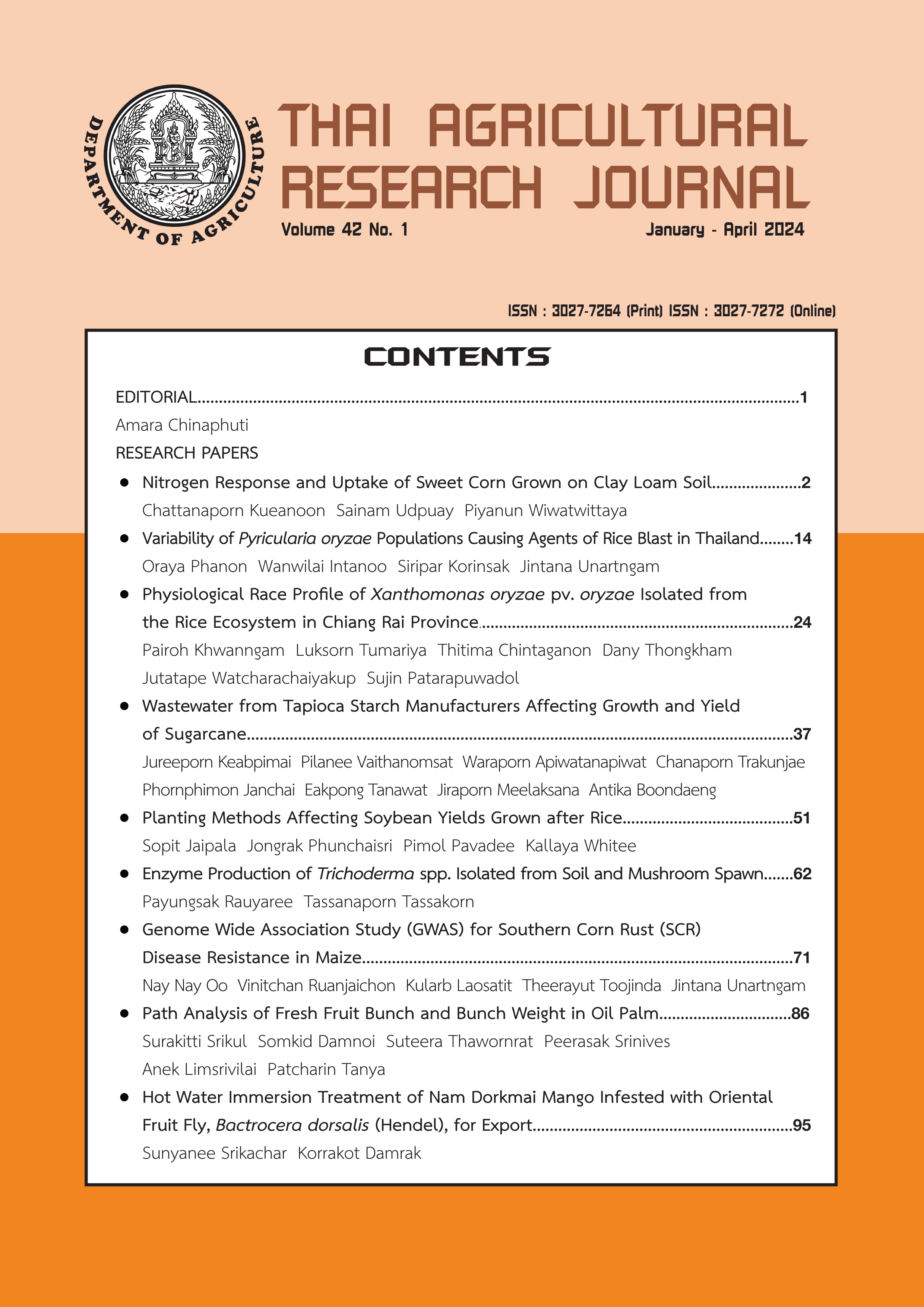Physiological Race Profile of Xanthomonas oryzae pv. oryzae Isolated from the Rice Ecosystem in Chiang Rai Province
DOI:
https://doi.org/10.14456/thaidoa-agres.2024.3Keywords:
bacterial leaf blight, Xanthomonas oryzae pv. oryzae, physiological race, diversityAbstract
This study investigated the diversity and distribution of the bacterial leaf blight (BLB) pathogen, Xanthomonas oryzae pv. oryzae (XOO) population in the diverse rice ecosystem of Chiang Rai province, Thailand. A total 274 XOO isolates were collected during 2016 to 2019 from 18 surveyed districts in the province. Representative isolates of each district were selected and physiological race analysis conducted on 11 near isogenic lines (NILs) with single BLB resistance genes. A total of 47 physiological races of XOO were identified, with the highest number of races found in Phan (26 races) and Chiang Saen (20 races). Rice with the xa5 resistance gene had broad-spectrum resistance to the pathogen population (76.3%), followed by Xa7 (62.4%), Xa21 (33.6%), and Xa11 (31.4%). Most of the isolates were in race 8 (SSSRRSSSSSS) (27.37%), followed by race 27 (SSSRRSSSSSR) (12.41%), and race 17 (SSSSSSSRRSS) (10.22%). Sixteen races were found to be able to infect NILs with the xa5 gene, and these isolates were isolated from rice varieties RD6 and KDML 105 in Phan and Chiang Saen districts. The 47 races were grouped into three clusters based on the similarity coefficient of the reaction response on rice with BLB resistance genes. The number of isolates and the effective controlling gene in cluster 1, 2, and 3 were 74 (xa5), 170 (xa5), and 30 (xa5 and Xa7) isolates, respectively. This study provides valuable information on the diversity and distribution of XOO races in Chiang Rai province, which can be used to manage new rice resistant cultivars for a sustainable controlling of BLB.
References
กนกอร เยาว์ดำ ประภา ศรีพิจิตต์ ธานี ศรีวงศ์ชัย และสุภาพร จันทร์บัวทอง. 2560. การพัฒนาสายพันธุ์ข้าวต้านทานโรคขอบใบแห้งโดยวิธีการผสมกลับและคัดเลือกด้วยเครื่องหมายดีเอ็นเอ. วารสารวิทยาศาสตร์ มข. 3: 595-604.
ธิติมา จินตกานนท์ จุฑาเทพ วัชระไชยคุปต์ ภัสสร วรรณพินิจ ภูมิพัฒน์ ทองอยู่ และสุจินต์ ภัทรภูวดล. 2565. ลำดับนิวคลีโอไทด์ทั้งจีโนมและโครงสร้างประชากรของเชื้อ Xanthomonas oryzae pv. oryzae สาเหตุโรคขอบใบแห้งของข้าวในประเทศไทย. วารสารวิชาการเกษตร. 40(1): 45 - 85
นงรัตน์ นิลพานิชย์. 2551. โรคที่เกิดจากแบคทีเรีย. สำนักวิจัยและพัฒนาข้าว กรมการข้าว กระทรวงเกษตรและสหกรณ์, กรุงเทพฯ.
ปริศนา วงศ์ล้อม จุฑาเทพ วัชระไชยคุปต์ สุจินต์ ภัทรภูวดล และวิชัย โฆสิตรัตน. 2558. การประเมินความหลากหลายในการก่อโรคของสายพันธุ์เชื้อ Xanthomonas oryzae pv. oryzae ในประเทศไทย. วารสารวิทยาศาสตร์เกษตร. 46: 165-175.
วิชัย โฆสิตรัตน. 2549. โรคพืชที่เกิดจากแบคทีเรีย: บทปฏิบัติการ. ภาควิชาโรคพืช มหาวิทยาลัยเกษตรศาสตร์ วิทยาเขตกําแพงแสน. 174 หน้า.
ศูนย์ความหลากหลายทางชีวภาพ. 2554. ข้าวกับวิถีกับวิถีชีวิตคนเจียงฮาย จากนวัตกรรมข้าว สู่คุณข้าวผลิตภัณฑ์ชุมชน. มหาวิทยาลัยราชภัฏเชียงราย. บริษัท เชียงใหม่ ดอคคิวเมนทารีดีไซน์ จำกัด. 32 หน้า.
แสงชัย ศรีประโคน. 2552. การจำแนกและจัดกลุ่มเชื้อแบคทีเรียสาเหตุโรคขอบใบแห้ง (Xanthomonas oryzae pv. oryzae) และการบ่งชี้ตำแหน่งยีนต้านทานในข้าวพื้นเมืองพันธุ์เชียงรุ้ง (Oryza sativa L.). วิทยานิพนธ์ปริญญาโท, มหาวิทยาลัยเกษตรศาสตร์.
Adachi, N. and T. Oku. 2000. PCR mediated detection of Xanthomonas oryzae pv. oryzae by amplification of the 16S-23S rDNA spacer region sequence. Journal of General Plant Pathology. 66: 303-309.
Delp, B.R., L.J. Stowell and J.J. Marois. 1986. Evaluation of field sampling techniques for estimation of disease incidence. Phytopathology. 76: 1299-1305.
Eamchit, S. and T.W. Mew. 1982. Comparison of virulence of Xanthomonas campestris pv. oryzae in Thailand and the Philippines. Plant Disease. 66: 556-559.
Kauffman, H.E., A.P.K. Reddy, S.P.Y. Hsieh and S.D. Merca. 1973. An improved technique of evaluation of resistance of rice varieties to Xanthomonas oryzae. Plant Disease Report. 57: 537-541.
Leach, J.E., H. Leung, R.J. Nelson and T.W. Mew. 1995. Population biology of Xanthomonas oryzae and approaches to its control. Current Opinion in Biotechnology. 6: 298-304.
Letunic, I. and P. Bork. 2007. Interactive Tree of Life (iTOL): an online tool for phylogenetic tree display and annotation. Bioinformatics. 23: 127-128.
Mew, T.W. 1989. An overview of the world bacterial blight situation, pp. 7-12. In: Proceedings of the International Workshop on Bacterial Blight of Rice. The International Rice Research Institute. Manila, Philippines.
Noda, T., C. Li, H. Ochiai, K. Ise and H. Kaku. 2001. Pathogenic diversity of Xanthomonas oryzae pv. oryzae strain from Yunnan Province, China. Japan Agricultural Research Quarterly. 35: 97 -103.
Ochiai, H., O. Horino and K.H. Miyajima. 2000. Genetic diversity of Xanthomonas oryzae pv. oryzae Strain form Sri Lanka. Phytopathology. 90: 415-421.
Perrier, X., A. Flori and F. Bonnot. 2003. Data analysis methods. pp. 43 – 76. In: Hamon, P., M. Seguin, X. Perrier and J.C. Glaszmann (Eds.), Genetic diversity of cultivated tropical plants. Science Publishers. Enfield, Montpellier.
Seint San A., M. Matsumoto, M.H. Kaku, T. Goto, N. Furuya and A. Yoshimura. 2008. Evaluation of resistance in rice plants to Myanmar isolates of Xanthomonas oryzae pv. oryzae. Journal of the Faculty of Agriculture, Kyushu University. 52: 17-21.
Tekete, C., S. Cunnac, H. Doucouré, M. Dembele, I. Keita, S. Sarra, K. Dagno, O. Koita, and V. Verdier. 2020. Characterization of new races of Xanthomonas oryzae pv. oryzae in Mali informs resistance gene deployment. Phytopathology. 110: 267-277.
Downloads
Published
How to Cite
Issue
Section
License
Copyright (c) 2024 Thai Agricultural Research Journal

This work is licensed under a Creative Commons Attribution-NonCommercial-NoDerivatives 4.0 International License.
Thai Agricultural Research Journal



